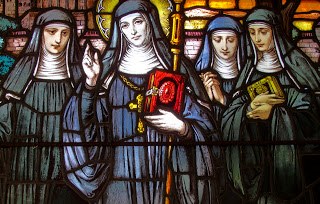Eventually she became abbess of the monastery at Heidenheim, a double monastery of men and women founded by her brother St. Wunibald, who served as its first abbot. The tenth-century legend of her life tells stories of her gentleness, humility and charity, as well as her power to heal the sick through prayer.
Many years after her death, her bones were taken from Heidenheim, then in ruins, to the town of Eichstätt, Bavaria, which had been founded by her brother St. Willibald, who served as its bishop. Her relics were entrusted to the care of a community of Benedictine nuns founded for the purpose of maintaining her shrine.
To everyone’s surprise, her bones produced a clear liquid, called “oil” for want of a more accurate word, which people began to use as a tool for prayer for the sick. Countless numbers experienced healing of body or spirit through her intercession. St. Walburga’s oil continues to flow every year from about October 12 to February 25 (the day of her death). It seeps from her relics through a thick slab of stone where it is collected and distributed by the nuns of the Abtei St. Walburg.

